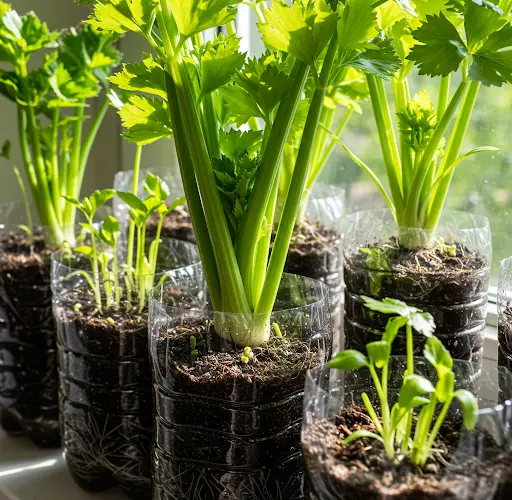Celery is a crisp, refreshing, and versatile vegetable that adds flavor and crunch to a variety of dishes. While it’s often thought of as a garden-only crop, celery is actually very easy to grow in containers, making it an excellent choice for balcony gardeners. With the right approach, you can enjoy a continuous harvest of celery in a small space, even if you live in an apartment or urban setting.
Balcony gardening doesn’t require a lot of room or effort—just a few containers, some good soil, and a bit of patience. Celery grown on a balcony can be just as productive as garden-grown crops, and even easier to manage since it’s right outside your door.
Here’s a complete guide to growing celery easily on the balcony and harvesting it continuously for months.
Why Grow Celery on the Balcony?
-
Space-saving: Celery grows vertically and compactly, making it ideal for containers.
-
Low-maintenance: With proper setup, it requires minimal care.
-
Fresh all the time: You can harvest stalks as needed, allowing the plant to keep growing.
-
Perfect for beginners: It’s a forgiving crop with simple needs.
Step 1: Choose the Right Variety
For balcony growing, look for compact or self-blanching celery varieties, as these are better suited to containers and limited space. Varieties such as ‘Utah’, ‘Golden Boy’, or dwarf hybrids work very well.
Step 2: Container and Soil Setup
Celery needs plenty of water and nutrient-rich soil, so selecting the right container is important.
Container Requirements:
-
Minimum depth of 8–10 inches.
-
Wide enough to allow at least 6 inches between plants.
-
Ensure good drainage—drill holes if needed.
Soil Mix:
-
Use a high-quality potting mix with added compost or worm castings.
-
Mix in coco peat or vermiculite to retain moisture.
-
Add a handful of organic slow-release fertilizer when planting.
Step 3: Starting Celery
You can grow celery either from seeds or by regrowing kitchen scraps.
From Seeds:
-
Soak seeds for 12 hours to improve germination.
-
Start seeds indoors or in a shaded area of your balcony.
-
Sow them shallowly, barely covering with soil.
-
Mist the surface to keep it moist until sprouting (takes 2–3 weeks).
-
Transplant to larger pots when seedlings are 3–4 inches tall.
From Scraps:
-
Cut off the base of store-bought celery.
-
Place it in a shallow bowl of water with the cut side up.
-
After 5–7 days, roots and new shoots will appear.
-
Transplant it into a container once roots are visible.
Step 4: Ideal Growing Conditions on the Balcony
Celery loves cool, consistent conditions, so your balcony setup should provide:
-
4–6 hours of sunlight per day.
-
Partial shade during hot afternoons to prevent wilting.
-
Consistently moist soil (not soggy).
To manage light, consider moving the containers or using shade cloth during peak heat.
Step 5: Caring for Your Celery
Watering:
-
Keep the soil evenly moist at all times.
-
Water deeply every 2–3 days, depending on weather.
-
Mulch the surface with dry leaves or straw to retain moisture.
Fertilizing:
-
Use a balanced organic liquid fertilizer every 2–3 weeks.
-
Compost tea or fish emulsion works well to boost growth.
Trimming & Tidying:
-
Remove any yellowing leaves at the base.
-
Keep the container area clean to avoid pests.
Step 6: Continuous Harvesting Tips
One of the best parts of growing celery on the balcony is the ability to harvest as needed, without pulling up the whole plant.
To harvest continuously:
-
Start picking outer stalks once they are firm and about 8 inches tall.
-
Always leave the inner stalks and growing center intact.
-
The plant will continue to grow new stalks for several weeks or even months.
-
Rotate harvesting from plant to plant if growing multiple pots.
This method keeps your celery producing fresh stalks regularly and reduces waste.
Step 7: Troubleshooting Balcony Celery
While celery is generally low-maintenance, here are a few common issues and their fixes:
-
Wilting: Usually due to underwatering or too much afternoon sun. Move to a shadier spot and increase watering frequency.
-
Pale leaves: May indicate nutrient deficiency—feed with compost tea or a seaweed-based fertilizer.
-
Pests: Watch for aphids or caterpillars. Spray neem oil or introduce beneficial insects like ladybugs.
Final Thoughts
Growing celery on your balcony is easier than it sounds. With just a few containers and consistent care, you can enjoy a steady supply of fresh, flavorful stalks for months on end. It’s a space-saving, satisfying project that’s perfect for small-space gardeners and anyone who loves fresh produce right outside their door.
Start with one or two pots and soon you’ll be hooked—balcony-grown celery is not only possible, it’s incredibly rewarding.



